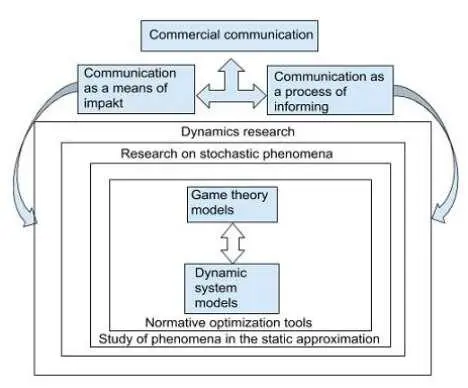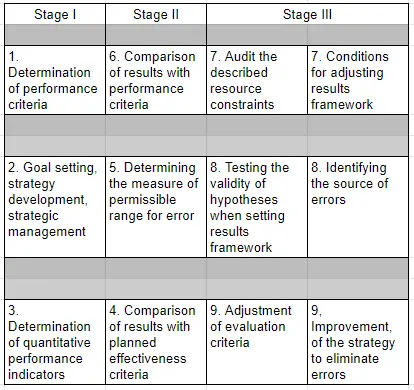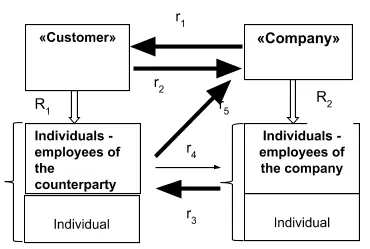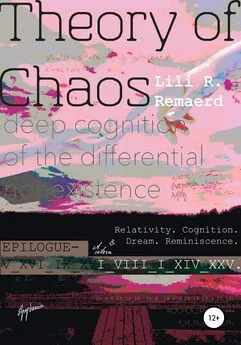Inna Borodina - Interdisciplinary theory of commercial communication. First part
- Название:Interdisciplinary theory of commercial communication. First part
- Автор:
- Жанр:
- Издательство:неизвестно
- Год:2022
- ISBN:978-5-532-95637-7
- Рейтинг:
- Избранное:Добавить в избранное
-
Отзывы:
-
Ваша оценка:
Inna Borodina - Interdisciplinary theory of commercial communication. First part краткое содержание
Interdisciplinary theory of commercial communication. First part - читать онлайн бесплатно ознакомительный отрывок
Интервал:
Закладка:

Fig. 1.– The system connections of mathematical tools and methods of modeling commercial communications.
As an initial premise, the methodology of analysis of management systems is used, based on a gradual transition from the macro level to the microeconomic level, that is, to the level of internal planning of the firm and decision-making in demand management (Fig.1).
The global formulation of the problem based on the price and informational prerequisites of consumer demand leads to the determination of the components of the commercial communications system in a competitive commodity market, which makes it possible to develop a schematic solution of the communication system in the commodity market. The analysis of the obtained circuit solution authorizes the possibility of identifying the typical information behavior of each of the competitors and localizing the problem setting by the criteria of in-house planning.
After developing a schematic solution for the trivial case of a commercial communication management system, in the case of considering one information channel, a conditional transition is either to the typology of the system and its schematic solutions, and then to model formalization, or directly to model formalization.
For a quantitative analysis of the behavior of the system as a whole, the behavior of each of the elements of the system is described by identifying microeconomic patterns, as well as by adapting the least squares method to identify microeconomic patterns, as well as numerically assessing the parameters of the functions of microeconomic development.
On the basis of the obtained microeconomic functions, a dynamic modeling of the "supply – demand for goods" commercial communication system and the information incentives management system is carried out, where the parameters that determine the behavior of the system reflect changes in the structure of connections between elements. The functions describing the dynamics of the system determine the change in the behavior of the system in time, and the vector of independent coefficients takes into account the influence of the external environment on the behavior of the elements.
The analysis of demand values, total costs and optimal prices and costs presupposes a conditional transition to the adjustment of input parameters and a new estimate of the change in demand over time. If the obtained values of the indicated quantities are accepted as satisfactory, then we can talk about the implementation in practice of the decision-making on demand management.
Based on the communication stages of the consumer's reaction to the advertising message, the targets of specific advertising events are formed, during which indicators of the change in demand for each brand product are recorded.
Positive effects at all intermediate stages of informing, up to the achievement of the target, are into tight functional tasks of communication. A prerequisite is the control at the early communication stages of the consumer's reaction to advertising, for example, in the form of recording the number of contacts and minimizing the cost of this contact. Without them, the chain of stages is broken, and the strategic target cannot be achieved (Fig. 2).
The main decision-making tools in the described conditions are: the criteria and objectives of the enterprise regulating the use of the resource (advertising costs); properties of the object to which the influence of the spent resource of the advertiser is directed; structural and economic principles of the relationship between the enterprise and the contractor; parameters of analytical tools for assessing the economic efficiency of a solution.
Strategic thinking requires restructuring the whole management system, increasing the efficiency of all departments and, ultimately, subordinating all elements of the product life cycle to the interests of the market. The main characteristics of decision-making are: clear consistency with the general target of the enterprise; informational authenticity; hierarchy of importance and advisability; economic profitability.

Fig. 2 – Model of management and control of communications.
At the level of the targets hierarchy, in the presence of the necessary achievement factors, the following increases: the effectiveness of communication as a contribution to commercial targets, sustainability and building a brand and business as a whole; science intensity, labor intensity, terms and cost of preparation and implementation of an advertising campaign; the degree of strategic partnership and trust in the work between the advertiser on the one hand and the advertiser on the other.
An enterprise, to successfully be in competition modern conditions, needs to fully use its communication potential.
There are two main approaches to evaluation the effectiveness of commercial communication using these assessment tools: economic and communication (informational or psychological interpretation of communicative relations).
At the same time, communication can be interpreted in a broad sense, as an interaction between all elements of the socio-economic system, as well as in the contexts of the way information is delivered to the recipient and options for its interpretation as a communicative act.
The possibility of building relationships with clients, creating a unified field of market interests in the future allows achieving a synergistic effect not due to material investments in business, but due to the intangible component of business interaction.
The competencies of employees, realized in the form of communication interaction with the client, can be presented as an additional attribute of the subject of the transaction. As noted by K.L.Keller, working in the field of creating and maintaining customer loyalty, it is necessary to create a "point of difference" in the minds of people1.
Sales strategies used by sellers of industrial consumer goods in B2B relations must be supported by a clear understanding of the information processing process, which occurs not in some abstract continuum by abstract actors, but by people making decisions in the space of "useful knowledge"2.
Those who purchase services can make their decisions not only in terms of corporate good, but also “influenced by emotional factors such as trust, safety and peace of mind”3. Strengthening relationships with consumers of the offered goods provides the basis for economic ties between contractors at the expense of the intangible assets of the parties to the relationship. The growth of the consumer value of the transaction is the main condition for the implementation of the customer loyalty program. Goodwill as a marketable asset is important because of its uniqueness, since by its nature it is an integral part of the company.
The purpose of the study is to study the influence of business reputation and its components on the process of concluding a deal as a result of communication between counterparties. Hypotheses: 1. Individual and professional competencies of employees, being complementary components of the good "business reputation of the organization", along with the brand and its recognition, influence a positive outcome when concluding a contract. 2. The content of the communication process between counterparties forms the consumer expectations of the participants.
The research methodology is based on an interdisciplinary approach, which includes: elements of cognitive analysis, systems theory and systems analysis, elements of contract theory, public relations management theory, information economics theory, behavioral economics, sociology.
Let us dwell in more detail on the conceptual prerequisites of competence, referring to the work of Lingham4, in which he identified areas of competence that are manifested at three levels: organizational, process and individual.
The problem under consideration, due to the specifics of communicative interaction, reflects the change in the state of the participants in communication over time. Thus, the communication interaction of employees-representatives of counterparties is an iterative process in which organizational, professional and individual competencies are involved.
To describe the model of communication interaction between counterparties, a linked type of information interaction between the seller and the consumer of the goods is determined. A linked type of interaction is an interaction in which free interaction leads to feedback. Such a scheme of interaction in the process of communication between contractors allows us to talk about the emergence of an open system of communicative relations. The stronger the interaction between participants, the higher the likelihood of feedback loops.
The parameters of the communication channel, which make it possible to ensure the availability of feedback, are the characteristics of the information transmission channel without interference, and the transfer of the counterparty to the “Customer” category, that is, the repeated purchase of goods, will be a characteristic of the self-organization of communication interactions. Communication costs are actually investments in the long-term capital of consumer preferences. The investment in customer loyalty pays off over a long period of time, and customer goodwill slowly devalues as it slowly gains in the market.
Making a consumer choice, the client motivates his actions by the desire to achieve the marginal utility through the purchase of goods, that is, he implements rational behavior. Consumer preferences in this case can be described by a utility function defined on the set of transaction attributes that have developed in the mind of the employee representing the client.

Fig. 2 – Communication interaction of counterparty.
The consumer's choice is obviously determined by his desire to maximize utility, so he searches not for a product, but for solutions to the problems that a contract can provide.
If there is an equilibrium contract price (a price that satisfies both parties), due to the absence of price influence, it is permissible to use a linear exchange model using the linear programming method similar to that presented in5.
I will dwell on the emerging interactions in more detail (Fig. 2). Interactions of the “Company” side: awareness of the seller's representatives about the subject of the transaction expressed in the form of professional competence (higher than that of the buyer); individual competencies of employees, coinciding with the social dominants supported by representatives of the "Customer".
The “Company” has the advantage of presenting the individual competencies of its employees, fulfilling the expectations of the counterparty at the interpersonal level. Interactions of the “Customer” side: awareness of the subject of the transaction, brand and business reputation of the counterparty (within the limits of professional competence); social awareness of the brand and business reputation (within the framework of individual competence). Representatives of the "Customer", along with business interests, are carriers of public opinion. Schematic solution of the communication interaction of contractors, presented in Fig.2 reflects the influence of professional and personal competences on the decision-making process in favor of concluding a contract when the organizational competence of the seller is satisfactory from the buyer's point of view.
Читать дальшеИнтервал:
Закладка:









